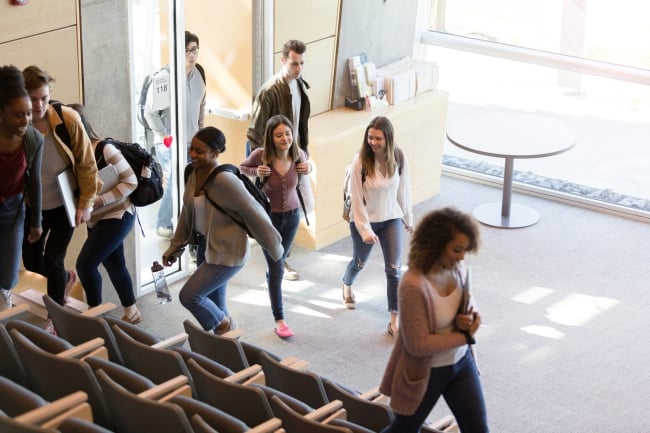You have /5 articles left.
Sign up for a free account or log in.

First-year students at Bunker Hill Community College complete career-exploration activities in their introductory courses.
SDI Productions/E+/Getty Images
Early career exploration and planning efforts can set students up for optimal success after completing their certificate or degree.
At Bunker Hill Community College in Boston, career-readiness is embedded throughout a student’s college career, allowing them to explore vocational interests and discover career mobility concepts as integrated into curriculum.
A May report from Jobs for the Future analyzed Bunker Hill’s initiative, Ethnographies of Work, which revamped the course curriculum and added interdisciplinary work, professional learning opportunities and additional career services support in the classroom.
Building off a model developed by Guttman Community College, of the City University of New York, Bunker Hill leaders adopted four learning outcomes to equip students with knowledge and a plan of how to better prepare for their life after higher education.
The need: For community college students, navigating college can be particularly challenging, and identifying a major can feel disconnected from overall career goals. Students can also be removed from career navigation support until immediately before graduation when searching for a job, and that’s if they complete their program.
“Pre-graduation career sessions happen too late to inform students’ course selection, career skills development, or participation in network building opportunities, such as internships or job shadows,” according to the Jobs for the Future report. “Many students never get to this point at all; with public two-year college completion rates hovering under 30 percent nationally, too few students who begin a two-year degree program ever reach the point where career advising is offered.”
Students of color and low-income and first-generation students can also be disadvantaged through a lack of career guidance in their K-12 education or personal networks. Community college students who select a general education or liberal arts degree and do not transfer to a bachelor’s program face challenges in accessing career-building experiences as well.
“If the two-year degree is to be a more reliable route to economic security, colleges need to do a better and more systematic job of preparing students for work,” the report says.
Bunker Hill has 16,000 students; 65 percent are students of color, around 80 percent are employed and around 60 percent are parents.
The background: At Bunker Hill, students first engage in career development in their first-year seminar, which is a requirement for all liberal arts majors and members of Learning Communities.
Guttman’s career development program, also called Ethnographies of Work, was a yearlong social sciences course that focused on vocation in work and how students could find their own vocation.
Career exploration was a learning outcome in the seminar since 2013, but it was more light-touch, at the discretion of the faculty member.
How it works: Starting in fall 2020 at Bunker Hill, a course was revamped to become the Humanities 120 seminar Self, Culture and Society. Its linked assignments build toward a final project or reflection on career preparation.
Some sample coursework includes completing an online career alignment survey, conducting an interview with a professional working in a field of interest, completing a job shadow or taking inventory of their own skills and socio-cultural capital.
Other 100-level courses at Bunker Hill now use EoW principles, including Business 101, BioTech 120 and English 111, and more advanced courses that pull from similar concepts adapt career-exploration ideas to be more discipline-specific.
With career exploration and personal development in the curriculum, students can identify their own goals and opportunities as related to their fields.
Faculty members opt in to EoW, and 15 of the 24 seminar sections in 2020 used the new career-engagement focus.
At present, faculty members lead the EoW curriculum and partner with career services staff to create employer connections and identify career-navigation tools.
The impact: Bunker Hill’s EoW initiative has four learning outcomes: inquire with intention, act to integrate knowledge and practice, communicate with purpose, and grow through continuous learning.
In 2021, a student survey found of students who engaged in EoW coursework, 64 percent were more confident in their job and career navigation, 71 percent had more knowledge on how their career choices would affect their lives, and 71 percent were more confident in their ability to identify a suitable career path.
As a result, more students had clearer goals in their career aspirations, with the majority more confident and more specific in their desired roles and a smaller portion revising their ideas. Students also gained a new understanding of their own career assets, like being bilingual, and were more likely to self-advocate in the workplace.
Looking ahead: In the future, Bunker Hill staff hope to connect EoW in sequences across multiple semesters to make the process iterative as students prepare for graduation. One idea is to create a three-point sequence starting with the first-year seminar, finishing with a capstone course and an interim course somewhere along the way.
Do you have an academic success tip that might help others encourage student success? Tell us about it.




